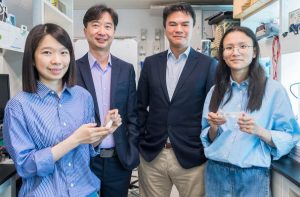It is a corrosion inhibitor that tackles ionic defects in the perovskite layer within the solar cell stack, even those created after manufacture.
“Applying a living passivator on the perovskite surfaces enhances their resistance to environmental factors like moisture and heat,” said CityUHK research engineer Wang Wei-Ting. “This improves the stability of perovskite solar cells in hot and humid conditions, introducing a dynamic, responsive approach to environmental stressors.”
A ‘hindered urea/thiocarbamate bond Lewis acid-base’ is the added material, which “leverages dynamic covalent bonds that activate on exposure to moisture and heat, enabling it to evolve new passivators in response to environmental factors”, said the university.
In perovskite solar cells with a conversion efficiency of 25.1%, the devices retained 94% of their efficiency after ~1,500 hours of aging at 85°C in nitrogen, and 88% after 1,000 hours in air at 85°C with 30% relative humidity.
Professor Feng Shien-ping from CityUHK’s Department of Systems Engineering lead the project, in collaboration with Professor Henry Snaith at the University of Oxford and Professor Angus Yip Hin-lap at the Hong Kong Institute for Clean Energy.
The work is described in the Nature paper ‘Water and heat-activated dynamic passivation for perovskite photovoltaics’ – abstract available without payment.
Photo, fellow CityUHK researchers (from the left): Wei-Ting Wang, Prof Feng Shien-ping, Prof Angus Yip Hin-lap and Ning Zhou.

